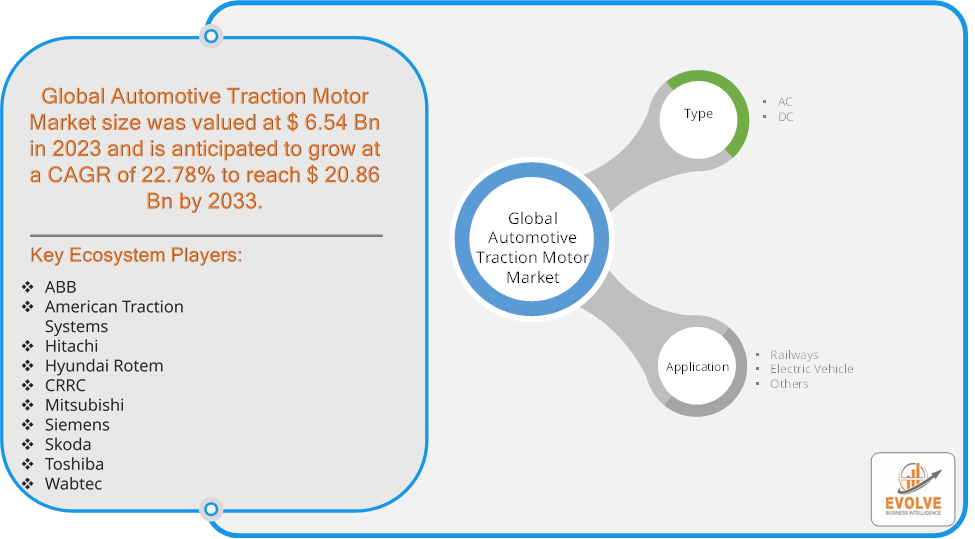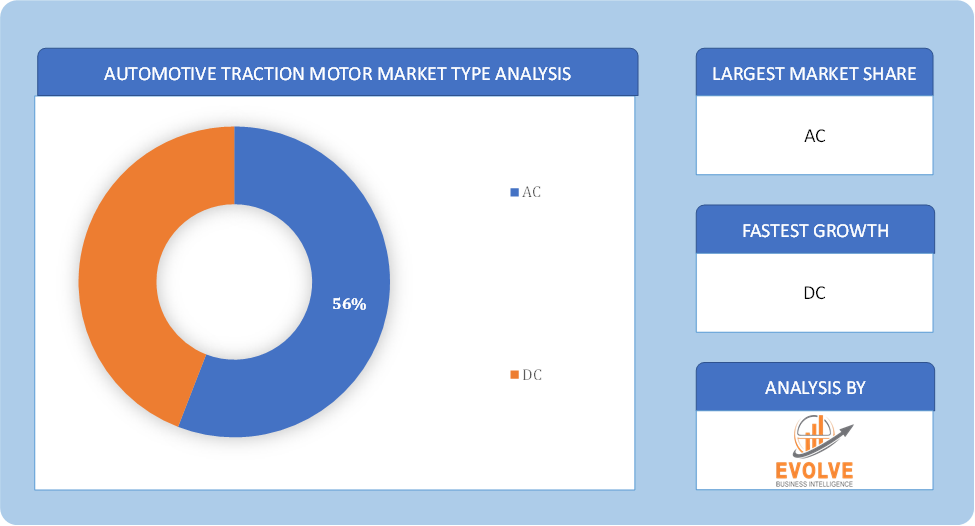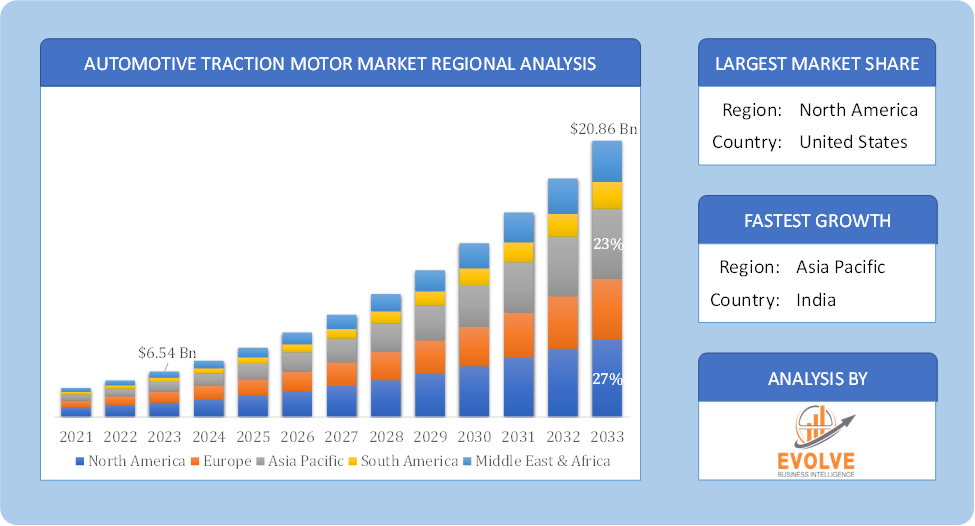Automotive Traction Motor Market Analysis and Global Forecast 2023-2033
$ 1,390.00 – $ 5,520.00Price range: $ 1,390.00 through $ 5,520.00
Automotive Traction Motor Market Research Report: Information By Type (AC, DC), By Application (Railways, Electric Vehicle, Others), and by Region — Forecast till 2033
Page: 153
Automotive Traction Motor Market Overview
The Automotive Traction Motor Market Size is expected to reach USD 20.86 Billion by 2033. The Automotive Traction Motor Market industry size accounted for USD 6.54 Billion in 2023 and is expected to expand at a compound annual growth rate (CAGR) of 22.78% from 2023 to 2033. The Automotive Traction Motor Market refers to the global market for traction motors specifically designed for use in automotive applications. These motors are critical components in electric vehicles (EVs) and hybrid electric vehicles (HEVs), as they convert electrical energy into mechanical energy to propel the vehicle. The market includes a variety of motor types, such as AC motors, DC motors, permanent magnet synchronous motors (PMSMs), and induction motors.
The Automotive Traction Motor Market is a critical component of the broader shift towards electrification in the automotive industry, reflecting growing environmental concerns and advancements in vehicle technology.
Global Automotive Traction Motor Market Synopsis
 COVID-19 Impact Analysis
COVID-19 Impact Analysis
The COVID-19 pandemic had a significant impact on the Automotive Traction Motor Market. During the peak of the pandemic, many automotive manufacturing plants were temporarily closed to prevent the spread of the virus. This led to a halt in the production of electric vehicles (EVs) and hybrid electric vehicles (HEVs), directly affecting the demand for traction motors. The economic uncertainty and reduced consumer spending during the pandemic led to a significant decline in overall vehicle sales, including EVs and HEVs. This directly impacted the demand for traction motors. The pandemic highlighted the need for resilience and innovation. Companies have been focusing on developing more efficient, reliable, and cost-effective traction motors to cater to the growing demand for electric mobility. The adoption of digital technologies and automation in manufacturing processes has accelerated, helping companies to improve efficiency and reduce dependency on manual labor. Post-pandemic, there has been a renewed focus on electrification and sustainability. Governments and automakers are increasingly committing to reducing carbon emissions, which is expected to drive long-term growth in the demand for traction motors.
Automotive Traction Motor Market Dynamics
The major factors that have impacted the growth of Automotive Traction Motor Market are as follows:
Drivers:
Ø Advancements in Motor Technology
Continuous advancements in traction motor technology lead to more efficient, compact, and lightweight motors, enhancing vehicle performance and range. Innovations in manufacturing processes and materials contribute to reducing the cost of traction motors, making electric vehicles more affordable. Modern traction motors are increasingly integrated with other vehicle systems, such as regenerative braking and advanced driver-assistance systems (ADAS), improving overall efficiency and functionality. Increasing urbanization and the development of smart cities promote the adoption of electric vehicles for urban mobility solutions. Electrification of public transportation systems, including buses and trams, requires advanced traction motors.
Restraint:
- Perception of Cost of Electric Vehicles and Battery Technology Limitations
Electric vehicles (EVs) generally have higher upfront costs compared to traditional internal combustion engine vehicles. This cost differential can deter price-sensitive consumers from opting for EVs, thereby limiting the immediate market size for traction motors. Despite advances, battery technology still faces challenges such as range limitations, charging time, and longevity. These factors influence the design and performance requirements of traction motors, affecting market growth.
Opportunity:
⮚ Expansion of Electric Vehicle (EV) Market
The increasing global demand for electric vehicles presents a substantial growth opportunity for traction motor manufacturers. As more countries and regions set ambitious targets for reducing carbon emissions and phasing out internal combustion engines, the demand for electric propulsion systems, including traction motors, is expected to surge. The proliferation of autonomous and connected vehicle technologies requires advanced traction motors capable of supporting sophisticated vehicle systems. Traction motors integrated with advanced driver-assistance systems (ADAS) and autonomous driving features represent a promising market opportunity for manufacturers.
Automotive Traction Motor Market Segment Overview
 By Type
By Type
Based on Type, the market is segmented based on AC and DC. the A.C. induction motor segment dominant the market. The A.C. induction motor segment in the traction motor market refers to motors that operate on alternating current, commonly used in electric and hybrid vehicles for their simplicity and reliability. A significant trend in this segment is the continued enhancement of motor efficiency and control systems.
By Application
Based on Application, the market segment has been divided into the Railways, Electric Vehicle and Others. Electric vehicles have more advanced and effective traction motors because they need powerful motors for propulsion. By charging the battery pack, these motors improve the power supply to electric vehicles and boost their overall efficiency. Due to the increased adoption of electric vehicles worldwide, traction motors used in electric vehicles are anticipated to experience significant growth during the forecast period.
Global Automotive Traction Motor Market Regional Analysis
Based on region, the global Automotive Traction Motor Market has been divided into North America, Europe, Asia-Pacific, the Middle East & Africa, and Latin America. North America is projected to dominate the use of the Automotive Traction Motor Market followed by the Asia-Pacific and Europe regions.
 Automotive Traction Motor North America Market
Automotive Traction Motor North America Market
North America holds a dominant position in the Automotive Traction Motor Market. United States and Canada is leading regions for electric vehicle (EV) adoption driven by supportive government policies, consumer demand for sustainable transportation, and a well-established automotive industry. Strong presence of electric vehicle manufacturers and technology companies driving advancements in traction motor technology and integration with autonomous driving systems.
Automotive Traction Motor Asia-Pacific Market
The Asia-Pacific region has indeed emerged as the fastest-growing market for the Automotive Traction Motor Market industry. China is largest electric vehicle market globally, driven by government initiatives to reduce air pollution and dependence on imported oil. Rapid expansion of charging infrastructure supported by government investments accelerates EV adoption and growing adoption of electric vehicles in countries like Japan, South Korea, and India, supported by urbanization, environmental concerns, and technological advancements.
Competitive Landscape
The global Automotive Traction Motor Market is highly competitive, with numerous players offering a wide range of software solutions. The competitive landscape is characterized by the presence of established companies, as well as emerging startups and niche players. To increase their market position and attract a wide consumer base, the businesses are employing various strategies, such as product launches, and strategic alliances.
Prominent Players:
- ABB
- American Traction Systems
- Hitachi
- Hyundai Rotem
- CRRC
- Mitsubishi
- Siemens
- Skoda
- Toshiba
- Wabtec
Key Development
In July 2021, Mercedes-Benz announced its acquisition of YASA Motors Ltd., a leading innovator in next-gen electric drive technology. As part of the agreement, YASA will become a wholly owned subsidiary of Mercedes-Benz, dedicated to the development of high-performance electric motors. This strategic move underscores Mercedes-Benz’s commitment to advancing electric mobility and enhancing its electric vehicle offerings.
Scope of the Report
Global Automotive Traction Motor Market, by Type
- AC
- DC
Global Automotive Traction Motor Market, by Application
- Railways
- Electric Vehicle
- Others
Global Automotive Traction Motor Market, by Region
- North America
- US
- Canada
- Mexico
- Europe
- UK
- Germany
- France
- Italy
- Spain
- Benelux
- Nordic
- Rest of Europe
- Asia Pacific
- China
- Japan
- South Korea
- Indonesia
- Austalia
- Malaysia
- India
- Rest of Asia Pacific
- South America
- Brazil
- Argentina
- Rest of South America
- Middle East & Africa
- Saudi Arabia
- UAE
- Egypt
- South Africa
- Rest of Middle East & Africa
| Parameters | Indicators |
|---|---|
| Market Size | 2033: USD 20.86 Billion |
| CAGR (2023-2033) | 22.78% |
| Base year | 2022 |
| Forecast Period | 2023-2033 |
| Historical Data | 2021 (2017 to 2020 On Demand) |
| Report Coverage | Revenue Forecast, Competitive Landscape, Growth Factors, and Trends |
| Key Segmentations | Type, Application |
| Geographies Covered | North America, Europe, Asia-Pacific, South America, Middle East, Africa |
| Key Vendors | ABB, American Traction Systems, Hitachi, Hyundai Rotem, CRRC, Mitsubishi, Siemens, Skoda, Toshiba and Wabtec. |
| Key Market Opportunities | · Expansion of Electric Vehicle (EV) Market · Integration with Autonomous and Connected Vehicles |
| Key Market Drivers | · Advancements in Motor Technology · Urbanization and Smart Cities |
REPORT CONTENT BRIEF:
- High-level analysis of the current and future Automotive Traction Motor Market trends and opportunities
- Detailed analysis of current market drivers, restraining factors, and opportunities in the future
- Automotive Traction Motor Market historical market size for the year 2021, and forecast from 2023 to 2033
- Automotive Traction Motor Market share analysis at each product level
- Competitor analysis with detailed insight into its product segment, Government & Defense strength, and strategies adopted.
- Identifies key strategies adopted including product launches and developments, mergers and acquisitions, joint ventures, collaborations, and partnerships as well as funding taken and investment done, among others.
- To identify and understand the various factors involved in the global Automotive Traction Motor Market affected by the pandemic
- To provide a detailed insight into the major companies operating in the market. The profiling will include the Government & Defense health of the company’s past 2-3 years with segmental and regional revenue breakup, product offering, recent developments, SWOT analysis, and key strategies.
Frequently Asked Questions (FAQ)
What is the study period of this market?
The study period of the global Automotive Traction Motor Market is 2021- 2033
What is the growth rate of the global Automotive Traction Motor Market?
The global Automotive Traction Motor Market is growing at a CAGR of 22.78% over the next 10 years
Which region has the highest growth rate in the market of Automotive Traction Motor Market?
Asia Pacific is expected to register the highest CAGR during 2023-2033
Which region has the largest share of the global Automotive Traction Motor Market?
North America holds the largest share in 2022
Who are the key players in the global Automotive Traction Motor Market?
ABB, American Traction Systems, Hitachi, Hyundai Rotem, CRRC, Mitsubishi, Siemens, Skoda, Toshiba and Wabtec are the major companies operating in the market.
Do you offer Post Sale Support?
Yes, we offer 16 hours of analyst support to solve the queries
Do you sell particular sections of a report?
Yes, we provide regional as well as country-level reports. Other than this we also provide a sectional report. Please get in contact with our sales representatives.
Press Release

Global Pharmaceutical Manufacturing Market to Reach $1.38 Trillion by 2035 with 7.35% CAGR, New Research Shows

The Global Mammography Market Is Estimated To Record a CAGR of Around 10.29% During The Forecast Period

Glue Stick Market to Reach USD 2.35 Billion by 2034

Podiatry Service Market to Reach USD 11.88 Billion by 2034

Microfluidics Technology Market to Reach USD 32.58 Billion by 2034

Ferric Chloride Market to Reach USD 10.65 Billion by 2034

Family Practice EMR Software Market to Reach USD 21.52 Billion by 2034

Electric Hairbrush Market to Reach USD 15.95 Billion by 2034

Daily Bamboo Products Market to Reach USD 143.52 Billion by 2034

Cross-border E-commerce Logistics Market to Reach USD 112.65 Billion by 2034
Table of Content
Chapter 1. Executive Summary Chapter 2. Scope Of The Study 2.1. Market Definition 2.2. Scope Of The Study 2.2.1. Objectives of Report 2.2.2. Limitations 2.3. Market Structure Chapter 3. Evolve BI Methodology Chapter 4. Market Insights and Trends 4.1. Supply/ Value Chain Analysis 4.1.1. Raw End Users Providers 4.1.2. Manufacturing Process 4.1.3. Distributors/Retailers 4.1.4. End-Use Industry 4.2. Porter’s Five Forces Analysis 4.2.1. Threat Of New Entrants 4.2.2. Bargaining Power Of Buyers 4.2.3. Bargaining Power Of Suppliers 4.2.4. Threat Of Substitutes 4.2.5. Industry Rivalry 4.3. Impact Of COVID-19 on the Automotive Traction Motor Market 4.3.1. Impact on Market Size 4.3.2. End-Use Industry Trend, Preferences, and Budget Impact 4.3.3. Regulatory Framework/Government Policies 4.3.4. Key Players' Strategy to Tackle Negative Impact 4.3.5. Opportunity Window 4.4. Technology Overview 12.28. Macro factor 4.6. Micro Factor 4.7. Demand Supply Gap Analysis of the Automotive Traction Motor Market 4.8. Import Analysis of the Automotive Traction Motor Market 4.9. Export Analysis of the Automotive Traction Motor Market Chapter 5. Market Dynamics 5.1. Introduction 5.2. DROC Analysis 5.2.1. Drivers 5.2.2. Restraints 5.2.3. Opportunities 5.2.4. Challenges 5.3. Patent Analysis 5.4. Industry Roadmap 5.5. Parent/Peer Market Analysis Chapter 6. Global Automotive Traction Motor Market, By Type 6.1. Introduction 6.2. AC 6.3. DC Chapter 7. Global Automotive Traction Motor Market, By Application 7.1. Introduction 7.2. Railways 7.3. Electric Vehicle 7.4. Others Chapter 8. Global Automotive Traction Motor Market, By Region 8.1. Introduction 8.2. North America 8.2.1. Introduction 8.2.2. Driving Factors, Opportunity Analyzed, and Key Trends 8.2.3. Market Size and Forecast, By Country, 2023-2033 8.2.4. Market Size and Forecast, By Product Type, 2023-2033 8.2.5. Market Size and Forecast, By End User, 2023-2033 8.2.6. US 8.2.6.1. Introduction 8.2.6.2. Driving Factors, Opportunity Analyzed, and Key Trends 8.2.6.3. Market Size and Forecast, By Product Type, 2023-2033 8.2.6.4. Market Size and Forecast, By End User, 2023-2033 8.2.7. Canada 8.2.7.1. Introduction 8.2.7.2. Driving Factors, Opportunity Analyzed, and Key Trends 8.2.7.4. Market Size and Forecast, By Product Type, 2023-2033 8.2.7.5. Market Size and Forecast, By End User, 2023-2033 8.3. Europe 8.3.1. Introduction 8.3.2. Driving Factors, Opportunity Analyzed, and Key Trends 8.3.3. Market Size and Forecast, By Country, 2023-2033 8.3.4. Market Size and Forecast, By Product Type, 2023-2033 8.3.5. Market Size and Forecast, By End User, 2023-2033 8.3.6. Germany 8.3.6.1. Introduction 8.3.6.2. Driving Factors, Opportunity Analyzed, and Key Trends 8.3.6.3. Market Size and Forecast, By Product Type, 2023-2033 8.3.6.4. Market Size and Forecast, By End User, 2023-2033 8.3.7. France 8.3.7.1. Introduction 8.3.7.2. Driving Factors, Opportunity Analyzed, and Key Trends 8.3.7.3. Market Size and Forecast, By Product Type, 2023-2033 8.3.7.4. Market Size and Forecast, By End User, 2023-2033 8.3.8. UK 8.3.8.1. Introduction 8.3.8.2. Driving Factors, Opportunity Analyzed, and Key Trends 8.3.8.3. Market Size and Forecast, By Product Type, 2023-2033 8.3.8.4. Market Size and Forecast, By End User, 2023-2033 8.3.9. Italy 8.3.9.1. Introduction 8.3.9.2. Driving Factors, Opportunity Analyzed, and Key Trends 8.3.9.3. Market Size and Forecast, By Product Type, 2023-2033 8.3.9.4. Market Size and Forecast, By End User, 2023-2033 8.3.11. Rest Of Europe 8.3.11.1. Introduction 8.3.11.2. Driving Factors, Opportunity Analyzed, and Key Trends 8.3.11.3. Market Size and Forecast, By Product Type, 2023-2033 8.3.11.4. Market Size and Forecast, By End User, 2023-2033 8.4. Asia-Pacific 8.4.1. Introduction 8.4.2. Driving Factors, Opportunity Analyzed, and Key Trends 8.4.3. Market Size and Forecast, By Country, 2023-2033 8.4.4. Market Size and Forecast, By Product Type, 2023-2033 8.12.28. Market Size and Forecast, By End User, 2023-2033 8.4.6. China 8.4.6.1. Introduction 8.4.6.2. Driving Factors, Opportunity Analyzed, and Key Trends 8.4.6.3. Market Size and Forecast, By Product Type, 2023-2033 8.4.6.4. Market Size and Forecast, By End User, 2023-2033 8.4.7. India 8.4.7.1. Introduction 8.4.7.2. Driving Factors, Opportunity Analyzed, and Key Trends 8.4.7.3. Market Size and Forecast, By Product Type, 2023-2033 8.4.7.4. Market Size and Forecast, By End User, 2023-2033 8.4.8. Japan 8.4.8.1. Introduction 8.4.8.2. Driving Factors, Opportunity Analyzed, and Key Trends 8.4.8.3. Market Size and Forecast, By Product Type, 2023-2033 8.4.8.4. Market Size and Forecast, By End User, 2023-2033 8.4.9. South Korea 8.4.9.1. Introduction 8.4.9.2. Driving Factors, Opportunity Analyzed, and Key Trends 8.4.9.3. Market Size and Forecast, By Product Type, 2023-2033 8.4.9.4. Market Size and Forecast, By End User, 2023-2033 8.4.10. Rest Of Asia-Pacific 8.4.10.1. Introduction 8.4.10.2. Driving Factors, Opportunity Analyzed, and Key Trends 8.4.10.3. Market Size and Forecast, By Product Type, 2023-2033 8.4.10.4. Market Size and Forecast, By End User, 2023-2033 8.5. Rest Of The World (RoW) 8.5.1. Introduction 8.5.2. Driving Factors, Opportunity Analyzed, and Key Trends 8.5.3. Market Size and Forecast, By Product Type, 2023-2033 8.5.4. Market Size and Forecast, By End User, 2023-2033 Chapter 9. Company Landscape 9.1. Introduction 9.2. Vendor Share Analysis 9.3. Key Development Analysis 9.4. Competitor Dashboard Chapter 10. Company Profiles 10.1. ABB 10.1.1. Business Overview 10.1.2. Government & Defense Analysis 10.1.2.1. Government & Defense – Existing/Funding 10.1.3. Product Portfolio 10.1.4. Recent Development and Strategies Adopted 10.1.5. SWOT Analysis 10.2. American Traction Systems 10.2.1. Business Overview 10.2.2. Government & Defense Analysis 10.2.2.1. Government & Defense – Existing/Funding 10.2.3. Product Portfolio 10.2.4. Recent Development and Strategies Adopted 10.2.5. SWOT Analysis 10.3. Hitachi 10.3.1. Business Overview 10.3.2. Government & Defense Analysis 10.3.2.1. Government & Defense – Existing/Funding 10.3.3. Product Portfolio 10.3.4. Recent Development and Strategies Adopted 10.3.5. SWOT Analysis 10.4. Hyundai Rotem 10.4.1. Business Overview 10.4.2. Government & Defense Analysis 10.4.2.1. Government & Defense – Existing/Funding 10.4.3. Product Portfolio 10.4.4. Recent Development and Strategies Adopted 10.12.28. SWOT Analysis 10.5. CRRC 10.5.1. Business Overview 10.5.2. Government & Defense Analysis 10.5.2.1. Government & Defense – Existing/Funding 10.5.3. Product Portfolio 10.5.4. Recent Development and Strategies Adopted 10.5.5. SWOT Analysis 10.6. Mitsubishi 10.6.1. Business Overview 10.6.2. Government & Defense Analysis 10.6.2.1. Government & Defense – Existing/Funding 10.6.3. Product Portfolio 10.6.4. Recent Development and Strategies Adopted 10.6.5. SWOT Analysis 10.7. Siemens 10.7.1. Business Overview 10.7.2. Government & Defense Analysis 10.7.2.1. Government & Defense – Existing/Funding 10.7.3. Product Portfolio 10.7.4. Recent Development and Strategies Adopted 10.7.5. SWOT Analysis 10.8 Skoda 10.8.1. Business Overview 10.8.2. Government & Defense Analysis 10.8.2.1. Government & Defense – Existing/Funding 10.8.3. Product Portfolio 10.8.4. Recent Development and Strategies Adopted 10.8.5. SWOT Analysis 10.9 Toshiba 10.9.1. Business Overview 10.9.2. Government & Defense Analysis 10.9.2.1. Government & Defense – Existing/Funding 10.9.3. Product Portfolio 10.9.4. Recent Development and Strategies Adopted 10.9.5. SWOT Analysis 10.10. Wabtec 10.10.1. Business Overview 10.10.2. Government & Defense Analysis 10.10.2.1. Government & Defense – Existing/Funding 10.10.3. Product Portfolio 10.10.4. Recent Development and Strategies Adopted 10.10.5. SWOT Analysis
Connect to Analyst
Research Methodology



 Automotive Traction Motor North America Market
Automotive Traction Motor North America Market


